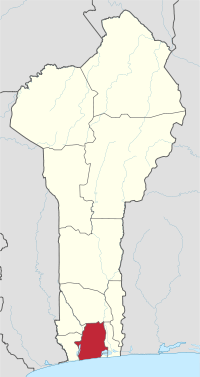Atlantique Department
| Atlantique | |
|---|---|
| Department | |
 | |
 Map highlighting the Atlantique Department | |
| Coordinates: 6°40′N 2°15′E / 6.667°N 2.250°ECoordinates: 6°40′N 2°15′E / 6.667°N 2.250°E | |
| Country |
|
| Capital | Ouidah |
| Area[1] | |
| • Total | 3,233 km2 (1,248 sq mi) |
| Population (2013 census) | |
| • Total | 1,396,548 |
| • Density | 430/km2 (1,100/sq mi) |
| Time zone | WAT (UTC+1) |
Atlantique is one of the twelve departments in Benin. The department is located in south central Benin along the Atlantic coast, between the Mono and Couffo in the west, Zou in the north, and Oueme in the east. Ethnically, the Fon at 61% constitute the majority of the population. They are followed by the Yoruba at 10%, Aja at 7%. Other groups make up the remaining 22%. Important towns in the department include Allada, Ouidah, Abomey-Calavi and Godomey. The département of Atlantique was bifurcated during 1999 when some of its territory were moved to the newly formed Littoral Department.
Per 2013 census, the total population of the department was 1,398,229 with 686,747 males and 711,482 females. The proportion of women was 50.90 per cent. The total rural population was 55.50 percent, while the urban population was 44.50 per cent. The total labour force in the department was 433,515 out of which 43.40 per cent were women. The proportion of households with no level of education was 39.20 and the proportion of households with children attending school was 77.30.
Geography

Benin is located in West Africa, bordered by Togo, Niger, Burkina Faso and Nigeria. The coastal areas have interconnected lakes and lagoons and elongated coastlines with wide marsh. Freshwater and seawater fishing is the major profession in the region. Petroleum was discovered in the 60s in offshore areas, while titanium, low quality iron ore, ilmenite and chromite are the major minerals.[2] The southern regions receive two spells from March to July and September to November while the northern regions of the country receive one season of rainfall from May to September. The country receives an average annual rainfall of around 1,200 mm (47 in), but the region in the department receives relatively lesser rainfall.[3] The department has mostly low-lying sandy coastal plains towards Atlantic Ocean, marshes, lagoons and lakes. The highest elevation in the department around the coastal plains is 20 m (66 ft) compared to the average 200 m (660 ft) above average mean sea level of the country.[4]
Demographics
Per 2013 census, the total population of the department was 1,398,229 with 686,747 males and 711,482 females. The proportion of women was 50.90 per cent. The total rural population was 55.50 percent, while the urban population was 44.50 per cent. The proportion of women in child bearing age of 15 to 49 years was 24.80 per cent. The total foreign population in the department was 16,517 which formed 1.20 per cent of the total population in the department. The propotion of assets of foreigners aged 10+ years was 37.80 per cent, while for the people aged 15-64 years, it was 37.30 per cent. The proportion of women in foreign population constituted 55.30 per cent. The number of households in the department was 298,769 and the average household size was 4.7. The intercensal growth rate of population was 5.10 per cent.[6]
The average age of women during first marriage in the department was 28.7 and the average age at maternity was 29. The synthetic index of fertility of women was 4.4. The average number of kernels in a house was 1.2 and the average number of persons in a room was 1.8. The total labour force in the department was 433,515 out of which 43.40 per cent were women. The proportion of households with no level of education was 39.20 and the proportion of households with children attending school was 77.30. The crude birth rate was 35.1, general rate of fertility was 141.50 and the gross reproduction rate was 2.20.[5]
Administrative divisions

Atlantique is subdivided into eight communes, each centered at one of the principal towns, namely, Abomey-Calavi, Allada, Kpomassè, Ouidah, Sô-Ava, Toffo, Tori-Bossito and Zè. The département of Atlantique was bifurcated during 1999 when some of its territory were moved to the newly formed Littoral Department. Benin, formerly known as Dahomey, was a French colony till 1894. It gained independence during 1960 and was admitted to the United Nations. From 1960 to 1972, there was political instability with frequent change of leadership.[7] Benin originally had six administrative divisions, but was further bifurcated to make it 12. Each de-concentrated administrative services, called directions départementales(DD) of the sectoral ministries, take care of two administrative regions. A law passed during 1999 empowered the territorial administration to local governments.[8] Municipalities and communal councils have elected representatives who manage the administration of the regions. The latest elections of the municipal and communal councils were held during June 2015.[9]
References
- ↑ "Benin". Geohive. Retrieved 25 November 2016.
- ↑ McColl, R. W. (2014). Encyclopedia of World Geography, Volume 1. Infobase Publishing. p. 92-93. ISBN 9780816072293.
- ↑ Haggett, Peter, ed. (2002). Encyclopedia of World Geography, Volume 17. Marshall Cavendish. p. 2325. ISBN 9780761473060.
- ↑ Benin Mineral & Mining Sector Investment and Business Guide. Int'l Business Publications. 2007. pp. 21–22. ISBN 9781433019012.
- 1 2 "Socio economic data of Benin, 2013". Institut National de la Statistique et de l’Analyse Economique (INSAE) du Benin. 2013. Retrieved 25 November 2016.
- ↑ "Census of Benin, 2013". Institut National de la Statistique et de l’Analyse Economique (INSAE) du Benin. 2013. Retrieved 25 November 2016.
- ↑ "Benin country profile". BBC. 5 August 2016. Retrieved 20 November 2016.
- ↑ Republic of Benin, Public Administration and Country profile (PDF) (Report). Department of Economic and Social Affairs (DESA), United Nations. 2004. p. 8. Retrieved 17 November 2016.
- ↑ "Local elections in Benin, 2015". African Elections Database. Retrieved 25 November 2016.